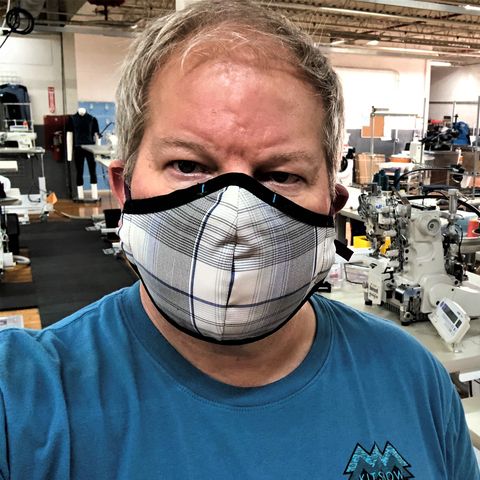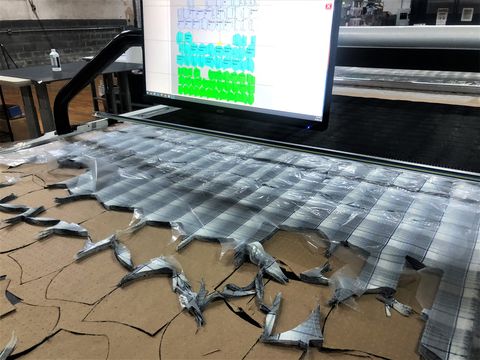As the coronavirus crisis overtook life in the United States, it quickly became apparent that healthcare organizations, swamped with a surge of cases, lacked vital personal protective equipment (PPE)—masks, gowns, and eye protection—to protect health care workers.
That gave Kitsbow founder Zander Nosler and CEO David Billstrom an idea: why couldn’t they make those products? A number of major companies like Under Armour, Gap Corporation, GE, and a consortium led by Hanes had similar ideas to make masks, gowns, and other PPE.
Additional bike and outdoor companies also jumped in—Italian clothing company Santini, Belgian custom-clothing company Vermarc, and travel case maker Orucase to name a few.
Also, eyewear company 100% donated shipments of protective glasses. Parts and accessory companies like 3T, Silca, and Industry Nine also offered their machining capabilities to companies attempting to make parts for equipment like ventilators.
So what could a boutique maker of cycling apparel offer on top of these efforts? Turns out, a lot. But making it happen hasn’t been easy.
Most apparel companies use subcontractor factories for production, which means they have to forecast their lineup and orders months in advance. Kitsbow’s production process, based on the made-to-order Toyota Way, is much more agile. “Our approach is ‘what do we want to make this week?’ and made-to-order is perfect for switching to masks,” Billstrom says.
The Kitsbow board of directors approved the idea to make masks on Thursday, March 19. The team leveraged Billstrom’s own knowledge of emergency medicine and a network of contacts in healthcare, and by the end of Sunday, March 22, Kitsbow had iterated two prototype designs, produced a batch of 500 samples, and had orders for 42,000 units, coming mostly from healthcare providers in western North Carolina.
Just three months ago, Kitsbow moved into an old hosiery factory just outside Asheville, North Carolina, and it has “90 brand-new sewing machines,” per Billstrom. And in keeping with its Toyota-style production ethos, all are mounted on rolling casters, so the modular production line could be reconfigured for mask-making in less than a day. In contrast, big companies take time to switch over their capabilities—the Hanes-led coalition says it won’t reach peak production until mid- to late April.
Kitsbow was simultaneously exploring making clear surgical face shields, through a collaboration with North Carolina wheel maker Industry Nine. “It was pretty apparent that we could go to much higher production numbers working together,” Industry Nine owner Clint Spiegel, who was previously a partner in a medical equipment company, says. (Fellow North Carolina outdoor companies Watershed Drybags and leather goods maker Oowee are also participating in the effort.)
It would be amazing if the story ended there: the North Carolina group ramps up production, ships PPE to area healthcare providers to protect them in the fight against SARS-CoV2, and we all live happily ever after. The reality is there are significant challenges.
Capacity doesn’t equal production, and right now materials availability is a serious bottleneck. Ordinarily, healthcare providers use either surgical masks or, when it comes to infectious disease, masks that are N95-rated, meaning they stop 95 percent of particles smaller than .3 microns. That matters because while there’s some debate over whether SARS-CoV2 is aerosolized, it spreads primarily through droplets as small as five microns—the cutoff definition for droplet vs. aerosol. Further, masks for medical settings must be FDA-approved; some masks used in industries like construction meet the N95 standard, but aren’t medical grade.
China is a primary producer of PPE, and between factory shutdowns and China’s own use (it imported some two billion masks), supply has been hit hard the past few months. But it’s been hard for others to pick up the slack, because the primary material used in N95 masks—a melt-blown polypropylene mat, rather than a woven fabric—is in short supply.
“We are in competition with other producers for this,” Billstrom says. “There’s no material on shelves right now in the U.S.” Distributors who promise it may not have access either, he added. “A key part of this has been unraveling the supply chain.”
So companies are resorting to other materials. Kitsbow is combining fabric it already has in stock with a removable High-Efficiency Particulate Air (HEPA) filter material, making the masks washable and re-useable. HEPA filters are even finer than N95; they screen almost 100 percent of particles to .3 microns. So in theory, it’s a better technology, but it’s not that simple, Billstrom warns.
“Filtration tech is something we’re learning a lot about,” he says. “It’s not just the size of the particle; there are considerations for surface tension, liquid versus gas, all kinds of things. This is all new for our crowd.”
Orucase is also using its existing fabric supplies used to make bike cases, along with a carbon filter material it initially explored for its odor-control properties. But owner Isaac Howe isn’t making any claims about the material’s filtering capability.
“We’ve been reaching out to get FDA guidance on materials, but I’ve had little success getting people on the phone,” he says. “The non-woven [N95] material is the issue for us; we’ve been having a hard time finding it.”
Until they get the material, Orucase, at least, is in something of a holding pattern. They’re making fabric masks for consumer use, and selling them to fund production of the medical masks they plan to make.
The issue of regulatory approval itself also complicates matters. Both the FDA and the CDC have shifted guidelines on PPE in medical settings multiple times since the coronavirus outbreak reached a critical point. Currently, FDA guidance essentially amounts to: use medical-grade PPE whenever possible, and when not, use the best thing you can find.
A further wrinkle is that hospitals and providers have their own rules on what to use in various situations. So for the time being, every order Kitsbow fills has a disclaimer that the products aren’t medical-grade PPE. “The user can decide if HEPA is enough for them or if they need something else,” Billstrom says. And based on the orders flowing in, most appear to have decided that whatever they can get will do. “They don’t have a lot of choice.”
The final obstacle is getting supplies to those who need it most. Companies Bicycling spoke with said that they are largely dealing directly with healthcare providers. There’s been almost no logistics coordination at the federal level and very little at the state or local levels—so distribution is largely local and ad hoc.
Orucase, based in San Diego and manufacturing just across the Mexican border, has largely been working with healthcare providers in Southern California. Kitsbow partnered with the Dogwood Health Trust, a non-profit foundation in western North Carolina created from the sale of Mission Health, a large healthcare provider in the area.
That’s worked for items like masks and face shields, even if it’s not ideal. But Industry Nine’s Spiegel says that its offer of manufacturing help for medical equipment parts hasn’t been met with interest. “The ventilator stuff isn’t going far right now,” he says. That may change as some big companies like GM start to source parts from subcontractors, and designs become available (Medtronic open-sourced its ventilator design last week). But for now, Spiegel says, they’re focusing on face shields.
If this seems dispiriting, it shouldn’t be. Rather than throw up their hands at the obstacles, companies like Kitsbow, Industry Nine, and Orucase are pushing through. While the companies are small, their capacities are not. Billstrom says Kitsbow can produce more than 30,000 masks a day and, with partners, 100,000 face shields a week; Orucase’s Howe estimates his factory in Mexico can churn out 500,000 masks a week. By way of comparison, Hanes is shooting for 1.5 million masks a week (the entire textile coalition will be able to do quite a few more: up to 10 million).
Even if there’s no time to get NIOSH certification or FDA approval for mask filtering technology, masks from the cycling companies will still help; wearing any kind of PPE is better than nothing. Many healthcare workers are already facing serious shortages, and masks and face shields, of almost any kind, would be an improvement. “A doctor in Seattle contacted us and said he had to use his mountain bike goggles while intubating a patient,” Spiegel says.
Supplying fabric masks to critical workers away from the front lines—whether they’re at managed-care facilities or grocery stores—reduces pressure on the supply of medical-grade masks. “Right now social workers don’t have protection, and they’re front line for disadvantaged populations,” Billstrom points out.
Finally, while it’s far from an immediate consideration, producing PPE means that companies like Kitsbow and Industry Nine may yet avoid the worst of the massive economic damage the virus is doing to small businesses. “Each week of the last three, it’s been harder to keep the workforce,” Spiegel admits.
New product development is on hold, but that’s partly because his engineering team is spending its time on solving PPE problems; it’s meaningful work they can do that keeps them employed. Billstrom said sales of Kitsbow’s regular products are off 60 percent or more. “If we weren’t in the mask business we’d have to make some [staffing] changes,” he says. But instead of laying off newly hired workers, Kitsbow is hiring more every day right now.
No one I spoke with plans to profit off the crisis. Orucase is selling consumer masks to pay for its medical production. Kitsbow is selling at cost, and right now only to healthcare providers. They hope, at most, to keep staff employed and cover costs, although those are hard to assess right now.
But even after the immediate crisis fades, there’s no going back to business as normal for Kitsbow, at least. Part of the reason we’re in this situation in the first place is that fast-response production capacity didn’t exist. Billstrom said that masks will be part of its product mix for the foreseeable future. “The explicit goal is to create a long-term, local production system for PPE so that this doesn’t ever happen again.”








